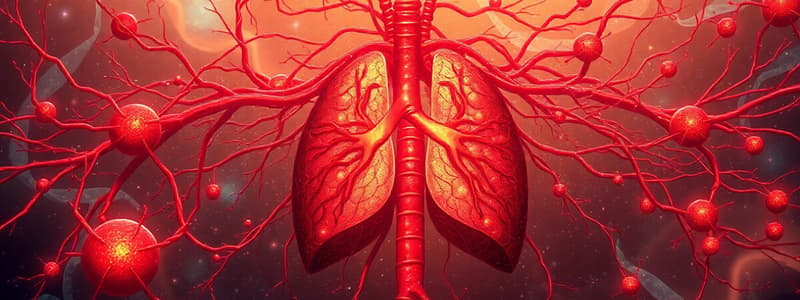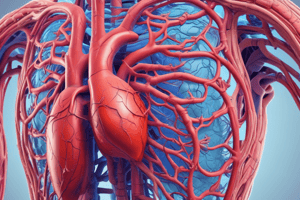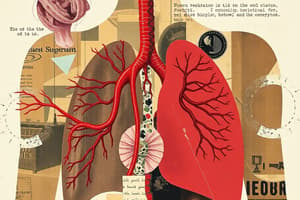Podcast
Questions and Answers
What is the lifespan of a monocyte in the blood?
What is the lifespan of a monocyte in the blood?
- 5 days
- 1 day
- 3 days (correct)
- 7 days
Which blood cell is primarily responsible for antibody production?
Which blood cell is primarily responsible for antibody production?
- T lymphocyte
- B lymphocyte (correct)
- Basophil
- Monocyte
What is the main function of eosinophils?
What is the main function of eosinophils?
- Inflammatory response
- Defense against parasites (correct)
- Blood clotting
- Cellular immune response
Which blood cell has a known lifespan of 7 to 8 days?
Which blood cell has a known lifespan of 7 to 8 days?
What is the primary function of T lymphocytes?
What is the primary function of T lymphocytes?
Which type of blood cell's lifespan remains unknown?
Which type of blood cell's lifespan remains unknown?
How many chambers does a human heart have?
How many chambers does a human heart have?
What is the precursor of tissue macrophages?
What is the precursor of tissue macrophages?
What are the primary elements that make up the vertebrate circulatory system?
What are the primary elements that make up the vertebrate circulatory system?
How does blood primarily move through the circulatory system?
How does blood primarily move through the circulatory system?
What role does the cardiovascular system play in temperature regulation?
What role does the cardiovascular system play in temperature regulation?
What is the function of capillaries in the circulatory system?
What is the function of capillaries in the circulatory system?
Which statement about veins is true?
Which statement about veins is true?
What characteristic allows capillaries to manage blood flow effectively?
What characteristic allows capillaries to manage blood flow effectively?
What process does the circulatory system utilize to protect against foreign microbes?
What process does the circulatory system utilize to protect against foreign microbes?
What distinguishes arteries from other blood vessels?
What distinguishes arteries from other blood vessels?
What is the function of smooth muscle in arterial walls?
What is the function of smooth muscle in arterial walls?
What structural feature distinguishes capillaries from arteries?
What structural feature distinguishes capillaries from arteries?
Why do veins have thinner walls compared to arteries?
Why do veins have thinner walls compared to arteries?
How does the presence of unidirectional valves in veins contribute to blood flow?
How does the presence of unidirectional valves in veins contribute to blood flow?
What is the primary distinction between open and closed circulatory systems?
What is the primary distinction between open and closed circulatory systems?
What components are dissolved in blood plasma?
What components are dissolved in blood plasma?
Which organisms are known to have a closed circulatory system?
Which organisms are known to have a closed circulatory system?
Which of the following statements is true regarding capillaries?
Which of the following statements is true regarding capillaries?
What is the fluid used in an open circulatory system called?
What is the fluid used in an open circulatory system called?
What is the primary role of proteins in blood plasma?
What is the primary role of proteins in blood plasma?
How does blood pressure in capillaries compare to that in arteries?
How does blood pressure in capillaries compare to that in arteries?
How do arthropods, such as insects, transport hemolymph?
How do arthropods, such as insects, transport hemolymph?
What is the role of arteries in a closed circulatory system?
What is the role of arteries in a closed circulatory system?
What is a key feature of the exchange process in a closed circulatory system?
What is a key feature of the exchange process in a closed circulatory system?
What is one of the main functions of a circulatory system?
What is one of the main functions of a circulatory system?
Which of the following statements is true regarding how nutrients and gases move in single-celled organisms?
Which of the following statements is true regarding how nutrients and gases move in single-celled organisms?
What is the main function of the left ventricle in the heart?
What is the main function of the left ventricle in the heart?
Which vessels return oxygen-rich blood from the lungs to the heart?
Which vessels return oxygen-rich blood from the lungs to the heart?
What is the primary function of the tricuspid valve?
What is the primary function of the tricuspid valve?
What causes the 'Lub' sound during a heartbeat?
What causes the 'Lub' sound during a heartbeat?
Where does the right ventricle send deoxygenated blood?
Where does the right ventricle send deoxygenated blood?
What measurement device is used to assess blood pressure?
What measurement device is used to assess blood pressure?
What characterizes diastolic pressure?
What characterizes diastolic pressure?
What happens if the heart valves do not fully close?
What happens if the heart valves do not fully close?
What is the primary function of alveoli in the human respiratory system?
What is the primary function of alveoli in the human respiratory system?
Which structure acts as the primary muscle for breathing?
Which structure acts as the primary muscle for breathing?
How does air primarily enter the lungs during inhalation?
How does air primarily enter the lungs during inhalation?
What role do the pleural membranes play in the respiratory system?
What role do the pleural membranes play in the respiratory system?
During exhalation, what causes air to be expelled from the lungs?
During exhalation, what causes air to be expelled from the lungs?
What is the main function of hemoglobin in the respiratory process?
What is the main function of hemoglobin in the respiratory process?
Which sequence correctly describes the path of air during inhalation?
Which sequence correctly describes the path of air during inhalation?
Which structure does NOT form a part of the upper respiratory tract?
Which structure does NOT form a part of the upper respiratory tract?
Flashcards
Open Circulatory System
Open Circulatory System
A circulatory system where the circulating fluid (blood) is not distinct from the body's extracellular fluid, and this fluid is called hemolymph. The hemolymph directly bathes the tissues.
Closed Circulatory System
Closed Circulatory System
A circulatory system where the circulating fluid (blood) is contained within blood vessels, is pumped by a heart, and is separate from body fluids.
Hemolymph
Hemolymph
The circulating fluid in an open circulatory system. It's a mixture of blood and body fluid.
Circulatory System Function: Transportation
Circulatory System Function: Transportation
Signup and view all the flashcards
Arteries
Arteries
Signup and view all the flashcards
Capillaries
Capillaries
Signup and view all the flashcards
Veins
Veins
Signup and view all the flashcards
Unicellular Protists
Unicellular Protists
Signup and view all the flashcards
Circulatory System
Circulatory System
Signup and view all the flashcards
Cardiovascular System
Cardiovascular System
Signup and view all the flashcards
Heart
Heart
Signup and view all the flashcards
Blood Vessels
Blood Vessels
Signup and view all the flashcards
Arteries
Arteries
Signup and view all the flashcards
Capillaries
Capillaries
Signup and view all the flashcards
Arterioles
Arterioles
Signup and view all the flashcards
Blood
Blood
Signup and view all the flashcards
Arterial wall layers
Arterial wall layers
Signup and view all the flashcards
Capillary function
Capillary function
Signup and view all the flashcards
Capillary structure
Capillary structure
Signup and view all the flashcards
Blood pressure in capillaries
Blood pressure in capillaries
Signup and view all the flashcards
Vein function
Vein function
Signup and view all the flashcards
Vein wall structure
Vein wall structure
Signup and view all the flashcards
Vein valves
Vein valves
Signup and view all the flashcards
Blood plasma components
Blood plasma components
Signup and view all the flashcards
Basophil lifespan
Basophil lifespan
Signup and view all the flashcards
Monocyte lifespan
Monocyte lifespan
Signup and view all the flashcards
B lymphocyte lifespan
B lymphocyte lifespan
Signup and view all the flashcards
T lymphocyte lifespan
T lymphocyte lifespan
Signup and view all the flashcards
Platelet lifespan
Platelet lifespan
Signup and view all the flashcards
Eosinophil function
Eosinophil function
Signup and view all the flashcards
Four-chambered heart
Four-chambered heart
Signup and view all the flashcards
Blood clotting function
Blood clotting function
Signup and view all the flashcards
Human Respiratory System
Human Respiratory System
Signup and view all the flashcards
Lungs
Lungs
Signup and view all the flashcards
Alveoli
Alveoli
Signup and view all the flashcards
Diaphragm
Diaphragm
Signup and view all the flashcards
Inhalation
Inhalation
Signup and view all the flashcards
Exhalation
Exhalation
Signup and view all the flashcards
Gas Exchange
Gas Exchange
Signup and view all the flashcards
Hemoglobin
Hemoglobin
Signup and view all the flashcards
Left Ventricle Function
Left Ventricle Function
Signup and view all the flashcards
Right Ventricle Function
Right Ventricle Function
Signup and view all the flashcards
Pulmonary Veins
Pulmonary Veins
Signup and view all the flashcards
Blood Pressure
Blood Pressure
Signup and view all the flashcards
Heart Sound - Lub
Heart Sound - Lub
Signup and view all the flashcards
Heart Sound - Dub
Heart Sound - Dub
Signup and view all the flashcards
Heart Murmur
Heart Murmur
Signup and view all the flashcards
Blood Pressure Measurement
Blood Pressure Measurement
Signup and view all the flashcards
Study Notes
Circulation and Respiration
- Learning changes everything.
- Essentials of the Living World, Seventh Edition is the textbook.
- The textbook authors are George Johnson and Joel Bergh.
- Unicellular protists obtain oxygen and nutrients directly through simple diffusion.
- Cnidarians and flatworms have cells directly exposed to the environment or gastrovascular cavity.
- Large animals have tissues that are multiple layers thick, making surface exchange difficult.
- Circulatory systems transport oxygen and nutrients from the environment and digestive cavity to body cells.
- Two types of circulatory systems exist: open and closed.
Open Circulatory Systems
- No distinction between circulating fluid (blood) and extracellular fluid.
- The fluid is called hemolymph.
- Insects have a muscular tube (heart) that pumps hemolymph through open-ended channels.
Closed Circulatory Systems
- Circulating fluid (blood) is always contained within blood vessels.
- Annelids (like earthworms) and all vertebrates have a closed circulatory system.
- Blood flows away from the heart in arteries.
- Gases and nutrients exchange through thin-walled capillaries.
- Blood returns to the heart via veins.
Circulatory System Functions
- Transportation of gases, nutrients, waste, and hormones.
- Regulation of body temperature (e.g., countercurrent heat exchange in vertebrates).
- Protection against injury and foreign microbes/toxins.
Vertebrate Circulatory System Architecture
- Consists of a heart, blood vessels, and blood.
- Blood travels from the heart through arteries, then arterioles, then capillaries for exchange, then venules, and finally back to the heart in veins.
- Capillaries have a large total cross-sectional area, allowing efficient exchange.
- Capillary beds can open and close based on tissue needs.
Artery Structure
- Arteries are more than simple pipes, needing to expand with heart pressure.
- Walls have three layers: innermost endothelial cells, middle elastic fibers and smooth muscle, and outermost connective tissue.
Capillary Structure
- Capillaries are narrow with thin walls for exchange.
- Almost all body cells are close to a capillary.
- Blood pressure is lower in capillaries than in arteries.
Vein Structure
- Vein walls are thinner than artery walls due to lower pressure.
- Veins have unidirectional valves that prevent backflow.
Blood Plasma Composition
- Blood plasma is a water solution with three dissolved substances: - Metabolites / wastes (e.g., glucose, vitamins, hormones). - Salts / ions (e.g., sodium, chloride, bicarbonate). - Proteins (help maintain water balance; include serum albumin, antibodies, globulins, and fibrinogen - important for clotting).
Cellular Components of Blood
-
Nearly half of blood volume is comprised of cells. - Red blood cells (carry oxygen using hemoglobin). - Hematocrit: The fraction of blood volume occupied by red blood cells (usually about 45% in humans). - White blood cells (part of the immune system). - Platelets (involved in blood clotting).
-
Red blood cells are flat disks with a central depression and are packed with hemoglobin.
-
White blood cells lack hemoglobin.
-
Platelets are cell fragments with a role in clotting.
Human Circulatory System
- Humans and other mammals have a four-chambered heart with two pumping circuits.
- One side pumps blood to the lungs for oxygen pickup, and the other side sends oxygenated blood to the body.
- The heart cycle involves the atria and ventricles; valves regulate blood flow.
- Oxygen-rich blood returns to the heart via pulmonary veins to the left atrium, then left ventricle and out to the body.
- Deoxygenated blood goes from the body through the vena cavae to the right atrium, then right ventricle, then to the lungs via pulmonary arteries.
Heart Sounds
- "Lub-dub" sounds are caused by valve closure during the heartbeat cycle.
- A heart murmur indicates incomplete valve closure.
Blood Pressure Measurement
- Sphygmomanometer is used to measure blood pressure.
- Systolic pressure is the peak pressure during ventricular contraction.
- Diastolic pressure is the lowest pressure during atrial filling.
Heart Contraction
- The heart's contraction is a coordinated process.
- The SA node is the heart's pacemaker, initiating the rhythm and atria contraction.
- The AV node delays the signal to the ventricles, allowing for the complete atrial contraction.
- The impulse passes down to a bundle of His, and then to Purkinje fibers, causing the ventricles to contract almost simultaneously. - ECG (electrocardiogram) measures electrical signals during the heart cycle.
Respiratory Systems
- Respiration involves oxygen uptake and carbon dioxide release.
- Most primitive animals obtain O2 through direct diffusion from the environment.
- More advanced animals have specialized respiratory organs such as gills, tracheae, and lungs; which improve the efficiency of respiration.
Human Respiratory System
- Lungs are terrestrial adaptations.
- A pair of lungs resides in the thoracic cavity.
- Air enters through the nasal cavity, pharynx, larynx (voice box), trachea, bronchi, bronchioles, and then into alveoli (for gas exchange with blood).
- The diaphragm and rib muscles drive breathing (inhalation and exhalation).
- Negative pressure draws air into the lungs during inhalation, and pressure increases during exhalation.
Respiration (Gas Exchange)
- Oxygen is transported by hemoglobin in the blood.
- Hemoglobin carries O₂ in the lungs, and releases it in tissues under high CO2 levels.
- CO2 is transported in the blood in several ways.
Studying That Suits You
Use AI to generate personalized quizzes and flashcards to suit your learning preferences.




